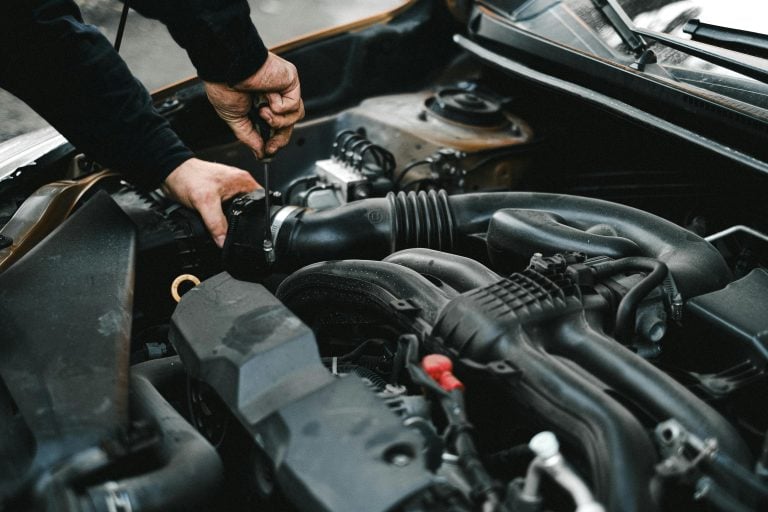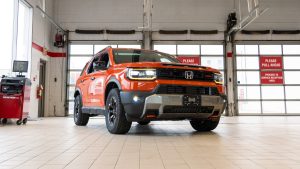Even the most reliable cars can encounter issues sometimes, from strange noises to alarming warning signs. Let’s look at common vehicle problems such as shaking steering wheels, squeaking brakes, fluid leaks, and overheating engines and explore how professional vehicle services at Birchwood can provide effective solutions to keep you safe on the road!
1. Check Engine Light is on:
The check engine light illuminates when the vehicle’s onboard diagnostic system detects a potential issue with the engine or emissions system. If the check engine light is blinking, a serious problem has occurred and you should stop driving your vehicle immediately.
Solution: A simple and common reason why the check engine light comes on is because of a loose gas cap. If that’s not the issue, it’s essential to have the vehicle’s diagnostic trouble codes (DTCs) scanned by a professional technician using a diagnostic scanner. Once the specific issue is identified, the technician can perform necessary repairs or component replacements to resolve the underlying problem, whether it’s a faulty sensor, or malfunctioning catalytic converter.
2. Hearing Weird Noises:
Strange noises such as squealing, grinding, rattling, or knocking can indicate various mechanical issues within the vehicle, including worn-out components, loose parts, or fluid leaks.
Solution: Often weird noises come from loose items in the side pockets of your vehicle rattling, so we recommend checking the interior of your vehicle as a first step. Otherwise, professional technicians can conduct thorough examinations of the vehicle’s systems, from the engine and transmission to the suspension and brakes, to identify the root cause of the noise. Once identified, the technician can perform necessary repairs or replacements to resolve the issue and restore quiet operation.
3. Car Won't Start:
A vehicle that fails to start can be attributed to several potential issues, including a dead battery, faulty starter motor, ignition system problems, or fuel delivery issues.
Solution: To troubleshoot why your car that won’t start, it’s essential to check the battery voltage, inspect the starter motor and ignition system, and verify fuel delivery to the engine. This is often due to a dead battery that needs to be charged or replaced. Technicians may also suggest repairing the starter motor, addressing ignition system faults, or diagnosing fuel system problems.
4. Vehicle Pulling to One Side:
When a vehicle pulls to one side while driving, it can indicate issues such as misaligned wheels, uneven tire wear, or brake problems on one side of the vehicle.
Solution: The most common solution to this is having a tire alignment done to adjust the angles of the wheels to the correct place. Additionally, technicians inspect the tires for signs of uneven wear and rotate or replace them as needed. If the pulling persists, the brake system can be inspected for issues such as stuck calipers or uneven brake pad wear, ensuring proper braking performance and vehicle stability.
5. Shaking Steering Wheel:
A shaking or vibrating steering wheel can indicate issues such as tire imbalances, worn suspension components, or misaligned wheels, compromising vehicle handling and safety.
Solution: To address a shaking steering wheel, professional technicians can conduct a thorough inspection of the vehicle’s suspension and steering components. This usually involves conducting a tire alignment, balancing the tires, or replacing worn-out suspension parts to restore smooth steering operation and improve driving comfort and safety.
6. Squeaking Brakes:
Squeaking or squealing noises when applying the brakes can indicate worn brake pads, warped rotors, or insufficient lubrication, compromising braking performance and safety.
Solution: To address squeaking brakes, professional technicians can inspect the brake system components, including the pads, rotors, calipers, and hardware. Depending on the condition of these components, repairs may involve replacing the brake pads, resurfacing or replacing the rotors, or lubricating the brake hardware to ensure quiet and effective braking operation.
7. Fluid Leaks:
Fluid leaks, whether oil, coolant, transmission fluid, or brake fluid, can compromise vehicle performance, safety, and reliability, leading to potential damage or component failures.
Solution: To address fluid leaks, professional technicians can perform a visual inspection of the vehicle’s undercarriage and engine bay to identify the source of the leak. Once located, the technician can determine the appropriate repair or replacement procedure, whether it involves repairing damaged gaskets or seals, replacing worn components, or tightening loose connections to prevent further fluid loss and maintain proper fluid levels.
8. Electrical System Malfunctions:
Electrical system malfunctions, such as flickering lights, dead batteries, or malfunctioning speakers, can be caused by issues such as faulty wiring, corroded connections, or failing components.
Solution: Professional technicians can perform diagnostic tests using specialized equipment to identify the root cause of the issue to address electrical system malfunctions. This usually involves inspecting the battery, alternator, starter, wiring harnesses, and electrical components to pinpoint the fault accurately. Once diagnosed, repairs may involve repairing or replacing damaged wiring, cleaning corroded connections, or replacing faulty electrical components to restore proper function and reliability.
9. Overheating Engine:
An overheating engine can result from issues such as coolant leaks, malfunctioning cooling fans, or a faulty thermostat, posing a significant risk to engine health and vehicle safety.
Solution: To address an overheating engine, professional technicians can perform a comprehensive inspection of the cooling system, including the radiator, hoses, water pump, and thermostat. Repairs usually involve repairing coolant leaks, replacing cooling system components, or flushing the radiator to remove debris and contaminants to restore proper engine temperature regulation.
10. Transmission Issues:
Transmission issues, such as slipping gears, delayed or rough shifting, or transmission fluid leaks, can indicate various problems within the transmission system, including worn clutches, damaged seals, or fluid contamination.
Solution: Addressing transmission issues usually involves inspecting the transmission fluid level and condition, conducting a road test to evaluate shifting behavior, and performing electronic diagnostics to check for trouble codes. Repairs can consist of replacing worn clutches, repairing damaged seals, or flushing the transmission fluid to remove contaminants and ensure smooth and reliable shifting operation.

When faced with common vehicle problems such as shaking steering wheels, squeaking brakes, fluid leaks, or overheating engines, seeking professional assistance is crucial for timely and effective solutions. At Birchwood, our staff consists of experienced technicians that can help you address issues promptly and ensure your vehicles remains safe and reliable on the road! Don’t let vehicle problems compromise your driving experience, schedule a service appointment today and experience the difference Birchwood’s professional automotive care can make!


